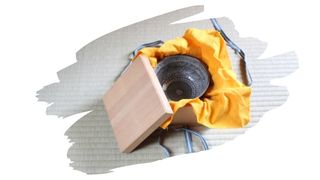Paulownia is a fast-growing tree that seemingly thrives wherever it takes root. Not only does this highly resilient tree grow up to 1.8 meters tall in a single year, it can do so in inhospitable environments.
Whether facing the coldest of winters or a bushfire wasteland, the Paulownia tree can flourish where other trees falter. Talk about a fighter!
What’s more, this fine grained lumber is easy to work with, and virtually knot free (unlike Pine wood). So, why aren’t more woodworkers using this sustainable hardwood?
Well, in this post, you will discover the top 3 pros and cons to working with either Paulownia or Pine. And we weigh the key differences between this hardwood lumber and it’s softwood counterpart.

This post may contain affiliate links to products that we receive a commission for (at no additional cost to you). Learn more here.
What Is Paulownia Wood (And What Is It Used For)?
Paulownia wood is a special hardwood sourced from South-East Asia. And this very fine-grained timber is one of the most lightweight woods around.
It is also incredibly buoyant to boot, and is often used in making surfboards and kayaks. This virtually knot-free wood can also be used to make furniture, toys, and musical instruments.
And What About Pine? What Is Pine Wood Suitable For?
Pine wood is used to make everything from floors to furniture, construction to cabinets. And Yellow Pine, (a native tree in southern states of the USA), has a distinctive tree-ring pattern that’ll give interior décor a rustic appearance.
So, What Separates Paulownia From Pine?
Other than the fact that Paulownia is a hardwood, and Pine a softwood? Well, there is a fair bit of difference between these two types of lumber…
Paulownia Wood Advantages And Disadvantages
Top 3 Paulownia Wood Advantages
1). Paulownia Is Stable And Does Not Warp
Paulownia wood is an incredibly stable wood (once it has been seasoned).
When it comes to Paulownia wood, moisture, humidity, and rain are like water off a ducks back. And this hardwood won’t warp, even under heavily humid conditions.
Wood warping is a result of wood expanding as it absorbs water, and then contracting as it dries out. That ‘movement‘ causes wood to twist and bend, throwing off the dimensions of a structure.
Related Post: What To Do When Solid Wood Cabinet Doors Start Warping (Solved!) | The Woodwork Place
However, Paulownia doesn’t move around like that. It is dimensionally stable, even after a drenching. And, it is so warp-resistant, it doesn’t even absorb much water.
Does That Mean Paulownia Wood Is Waterproof?
It isn’t waterproof, and this wood will take in water. However, the amount of water it absorbs is miniscule compared to other types of timber.
So, Paulownia is highly rot-resistant, and wood-munching bugs and insects can’t burrow into it either.
2). Paulownia Is Sustainable
This hardwood tree grows like a weed, and can add six foot to it’s height in a single year. They are also one of the plant worlds ultimate fighters, and can find purchase in even the most desolate of places.
Through scorching heat, and bone-chilling winters, Paulownia trees have been known to grow (and even thrive) under these conditions. Which means that these trees grow quickly and are plentiful.
3). Paulownia Is Ideal For Lightweight Furniture
To say that the Paulownia wood is light, is a bit of an understatement. However, don’t let this fool you. This featherweight lumber is very strong for its weight.
So, Is Paulownia Wood Good For Furniture?
Yes, it is. It can also be used to make weight-bearing furniture and load-bearing packing boxes too.
Top 3 Paulownia Wood Disadvantages
1). Paulownia Wood Has A High Tannin Content
Tannins are a compound found in plant life all around us. This chemical compound helps prevent moss and fungi from growing on tree bark.
Now, this is generally a good thing overall. However, wood that has very high tannin levels can contain so much of the stuff that it ‘bleeds’ out, even long after that tree has been seasoned and processed.
So, certain types of wood, (such as Cedar, Redwood and Paulownia), can contain high levels of tannins. And, unless they’re properly sealed, those tannins will bleed right through a top coat finish.
This, in turn, will create brownish-looking stains right across the surface of wood.
2). Paulownia Wood Dents Easily
Paulownia is very soft, and can be as easy to carve as say Balsa wood. However, it’s softness means that Paulownia wood can dent easily, with its wood fibers crushing under even the smallest of impacts.
Mind you, this wood won’t break under impact. But, scratches and dents will mar the overall finish, making this wood look worn out well before it’s time.
3). Paulownia Wood Is Borderline Invasive
If you’ve thought about planting some Paulownia wood on an acre of land, maybe think twice before doing so.
This tree is so sustainable that it grows fast…and spreads even faster. Each tree can scatter tens of thousands of seeds.
And each seed can take as little as 21 days to take root and grow in even harsh conditions.
Still, that’s Paulownia wood for you. But, how does Pine wood compare and contrast as a wood choice?…

Pine Wood Advantages And Disadvantages
Top 3 Pine Wood Advantages
1). Pine Wood Is Stable Too
This softwood timber doesn’t shift, expand, and contract all that much. This is why it is used for outdoor construction.
There are more stable timber choices for outdoor structures, (such as Douglas Fir). But, for its price, Pine wood can get the job done well enough. Which brings us onto the second big advantage of this lumber…
2). Pine Wood Is Affordable
It is more affordable than most any other type of wood used for outdoor construction. That’s because, just like Paulownia, Pine is a sustainable wood that grows both fast and abundantly.
3). Pine Wood Has A Great Aroma
That pleasant Pine scent is the result of aromatic chemical compounds found inside Pine wood. And it’s these compounds that give Pine it’s famously fresh scent.
Top 3 Pine Wood Disadvantages
1). Pine Wood Dents Easily
Pine wood isn’t as soft as Paulownia, but it can dent easily all the same.
These dents are the result of Pine wood fibers compacting and compressing under impact. Still, you can fix many of these Pine wood dents with a bit of steam pressing.
2). Pine Is Not Naturally Rot Resistant
Unlike Paulownia, Pine is not very water-resistant or rot-resistant. It needs to be chemically treated if it is to be used for exterior construction.
This chemical treatment, (also known as pressure treating), will infuse Pine with all of the wood preservatives it will need to survive life outside.
Without pressure treatment, however, outdoor Pine wood will rot away within 5 years.
Related Post: How To Dry Pressure Treated Wood (Quickly And Without Warping) | The Woodwork Place
3). Pine Wood Is Filled With Knots
Pine is one of the most knot-filled woods on the market. And those knots can make life difficult when it comes to working or carving this timber.
Related Post: Is Pine Good For Carving? (9 Facts You Need To Know!) | The Woodwork Place
You’ll need to use a knot-blocking wood primer, if you want to prevent sap from seeping out of this timber and through paint or other finishes.
So, Which One Is Better? Paulownia Wood or Pine Wood?
For workability, Paulownia wins out because this hardwood is easier to work and machine (compared to Pine). It’s a much better option for carving. And it can be a great alternative to using Balsa wood.
But, when it comes to accessibility, Pine is much easier to get a hold of in the US, Canada, and UK. Sure, it’s not quite soft enough for lightweight crafts and easy woodcarving.
Still, it is highly affordable, so it’s a great lumber for making your woodworking ‘mistakes’ on as you learn.
References:
Ab Latib, H., Choon Liat, L., Ratnasingam, J., Law, E. L., Abdul Azim, A. A., Mariapan, M., and Natkuncaran, J. (2020). “Suitability of paulownia wood from Malaysia for furniture application,” BioRes. 15(3), 4727-4737.
Why do pine trees smell good? | EarthSky.org
Controlling Paulownia – Tips On Getting Rid Of Royal Empress Trees | GardeningKnowHow.com



